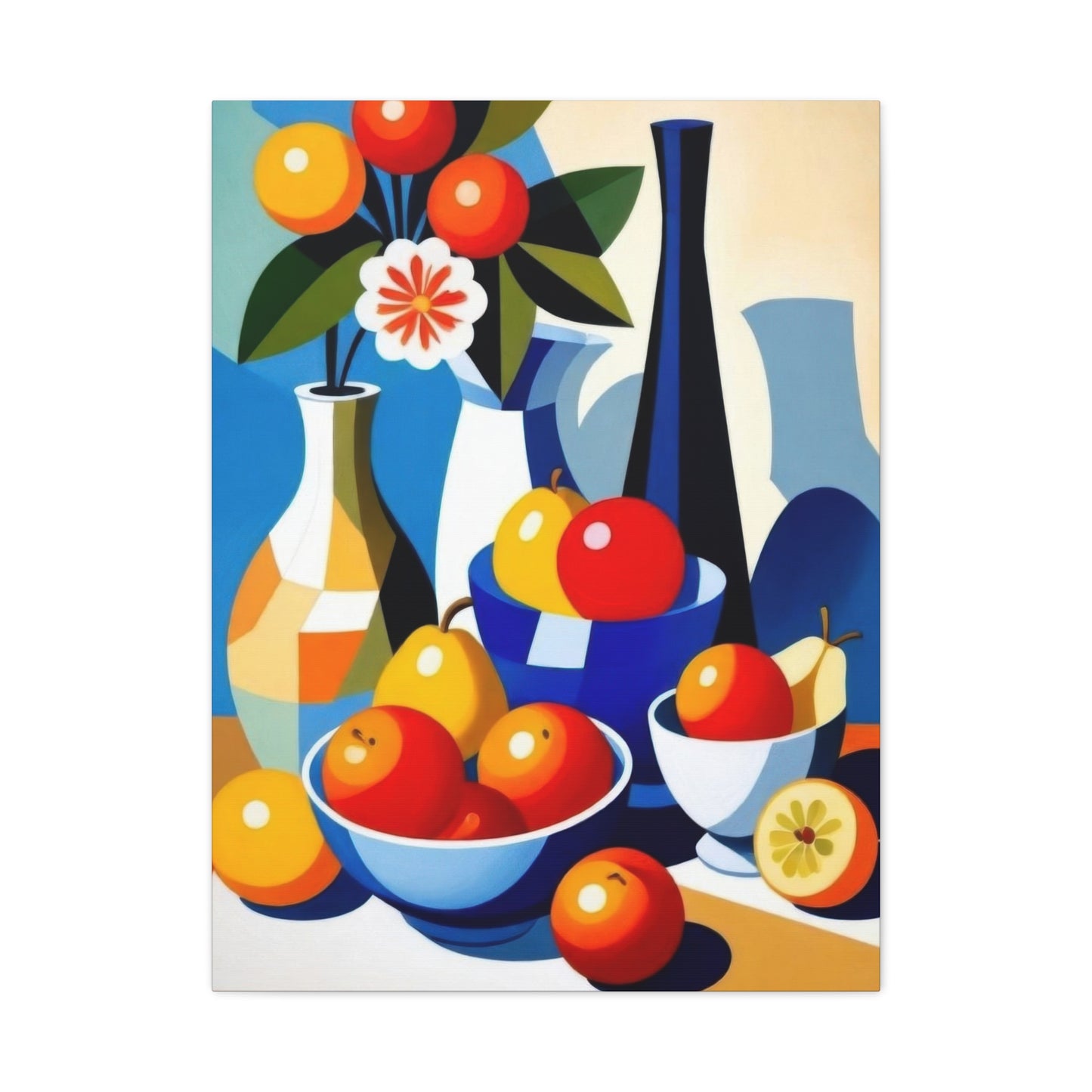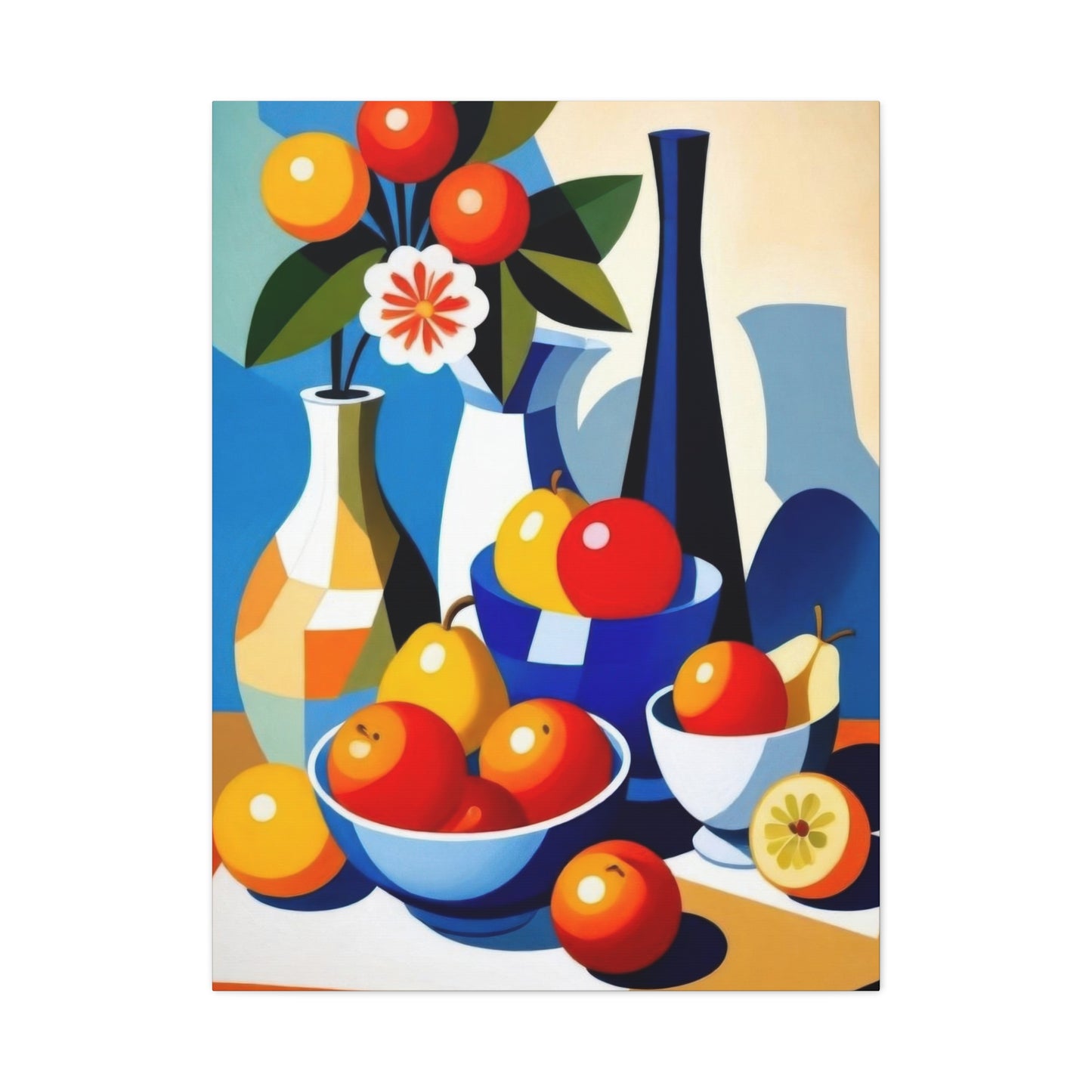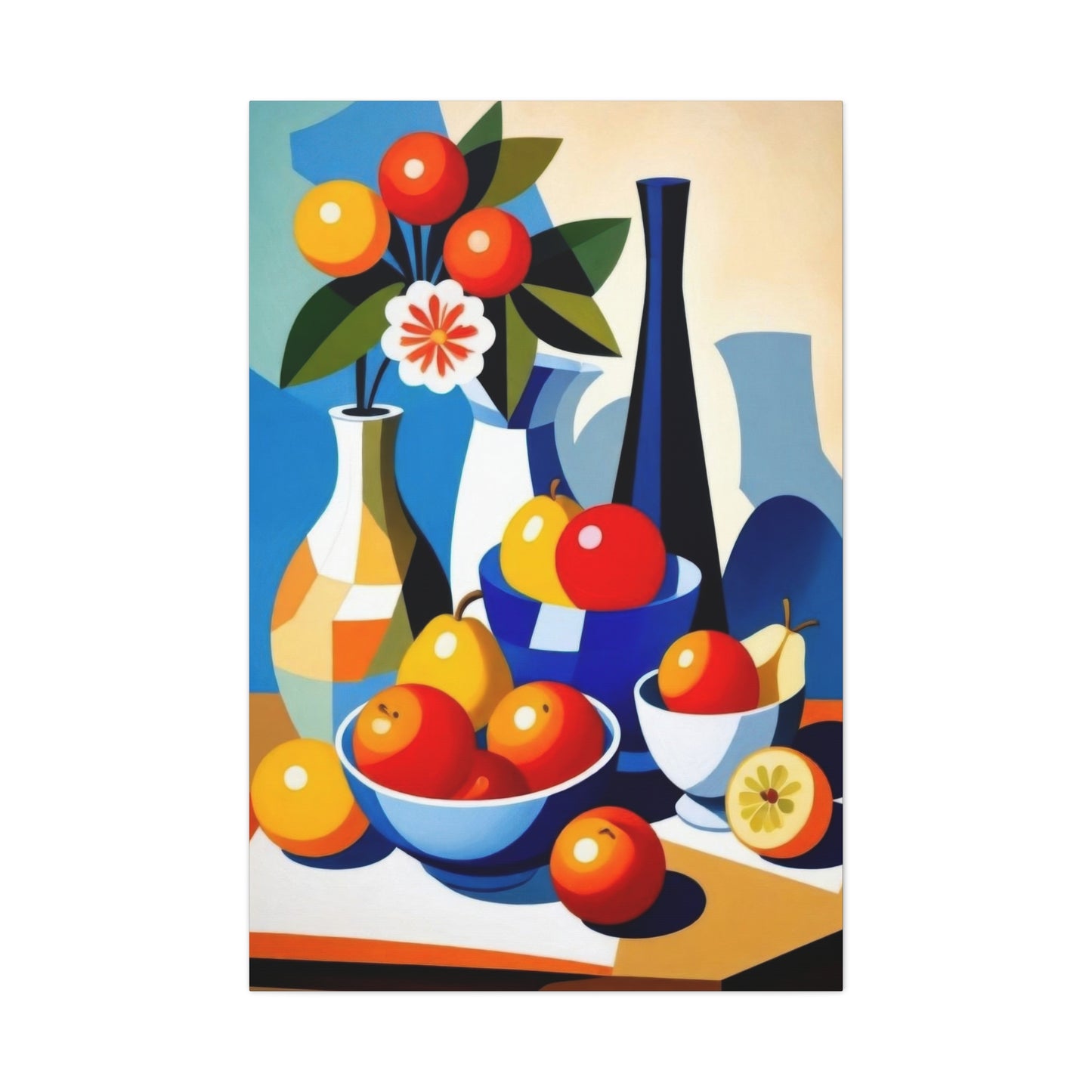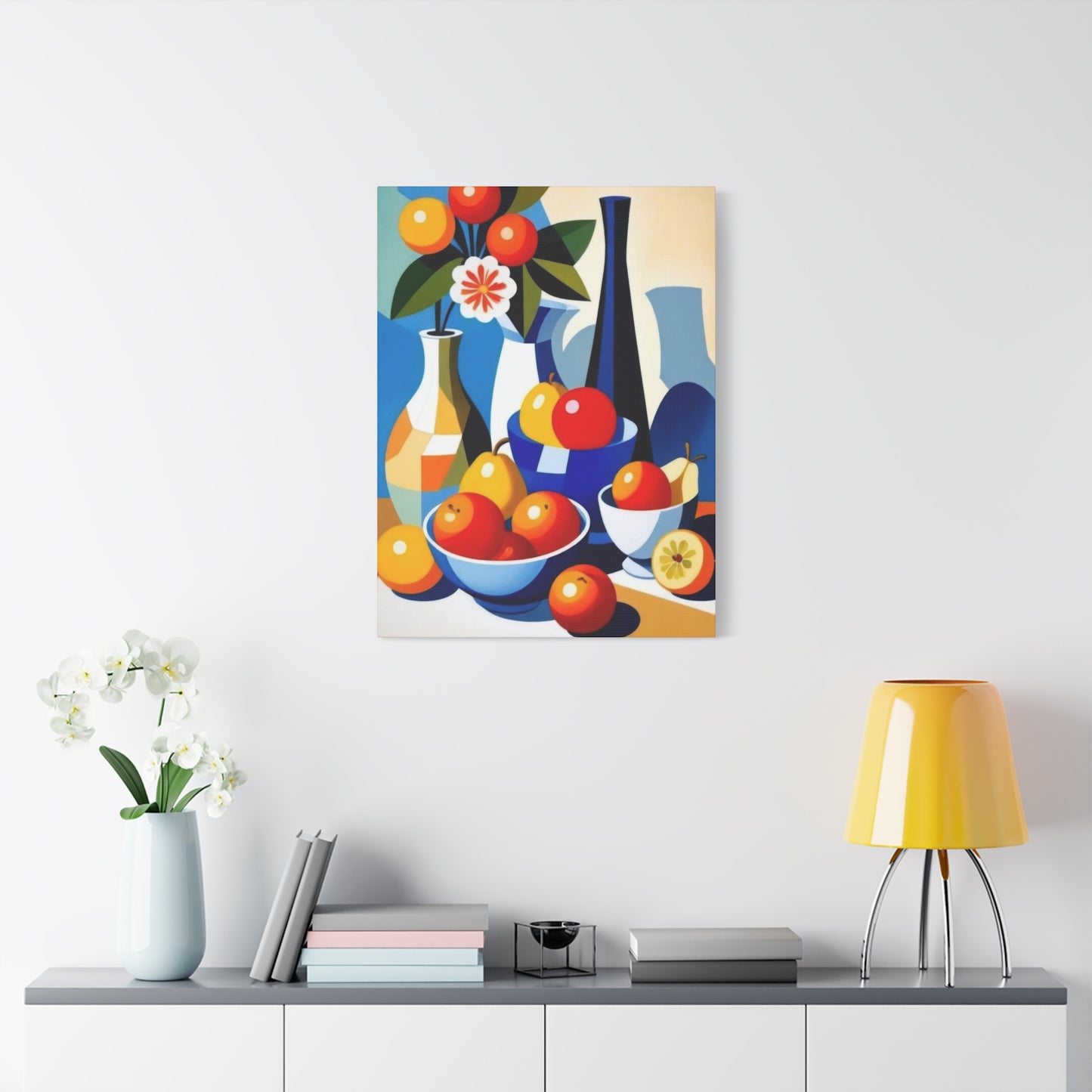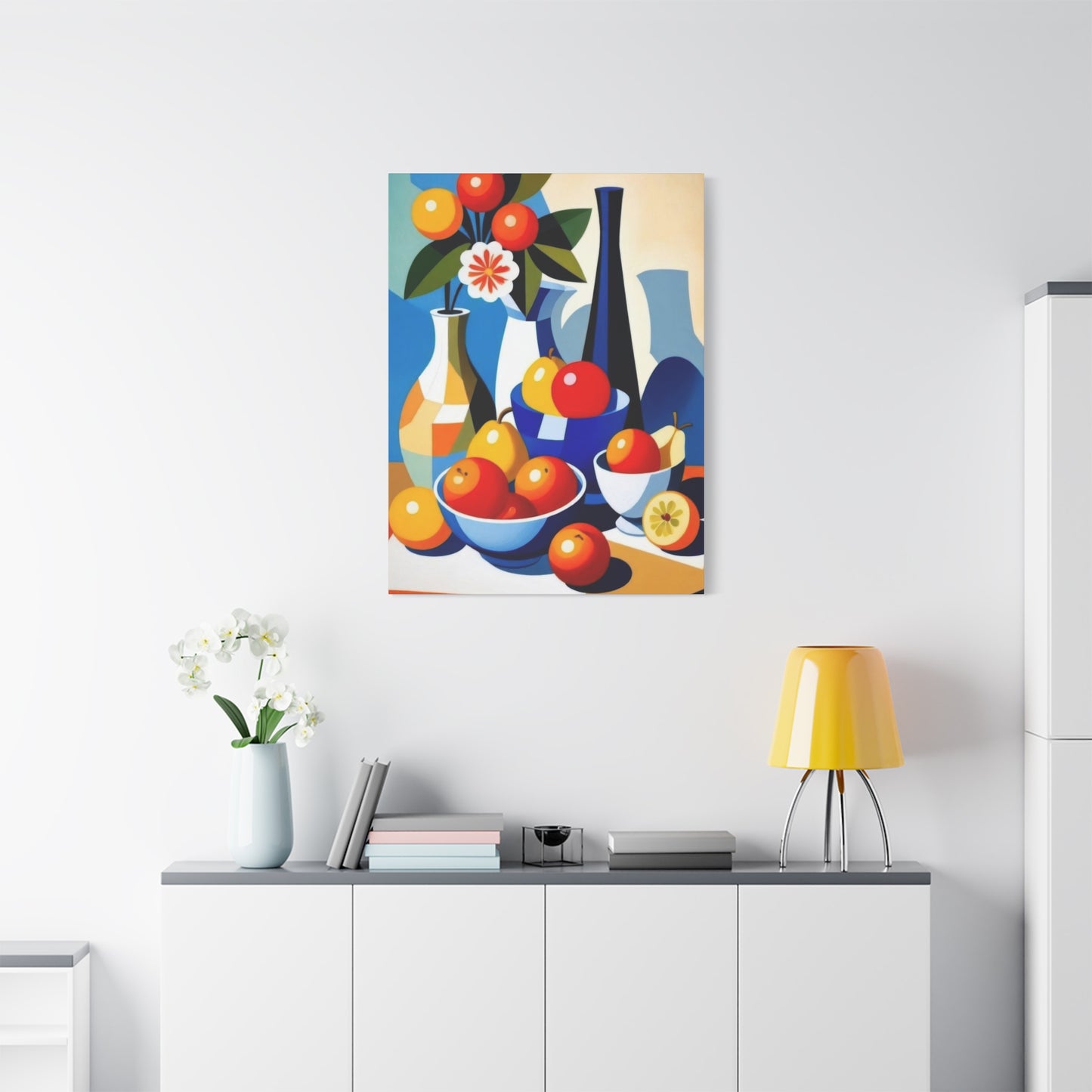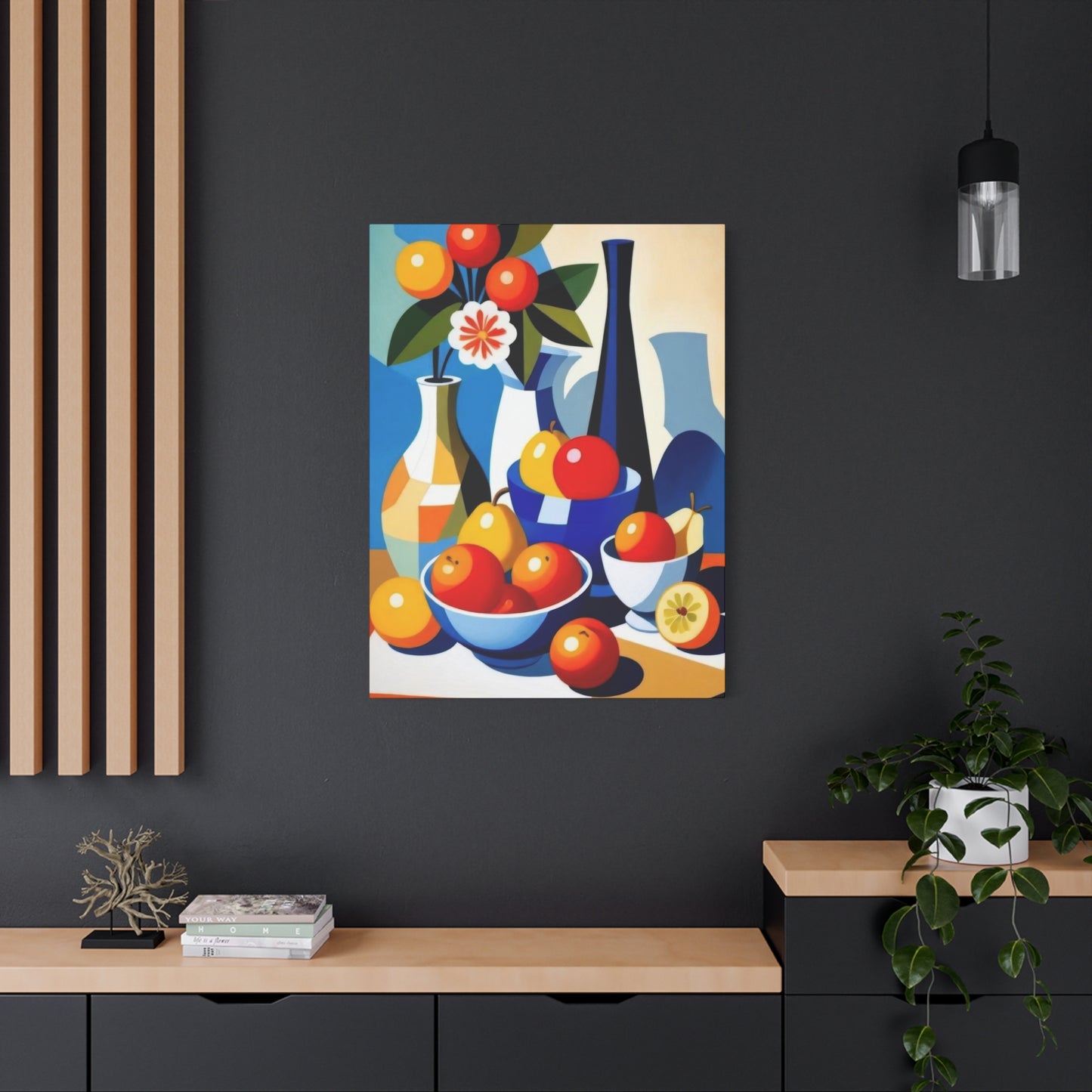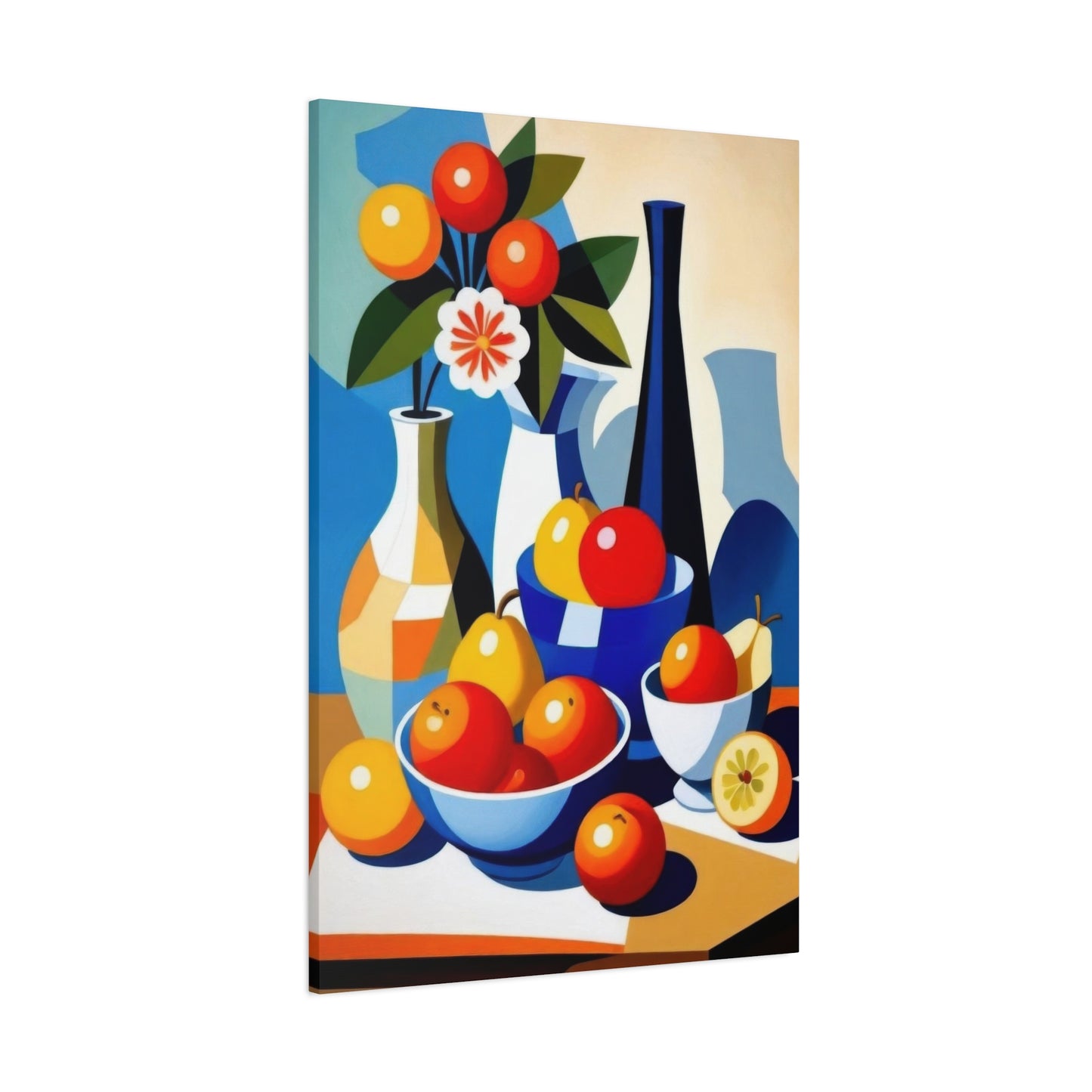Vibrant Living Spaces: Decorating with Fruit Flower Multicolor Wall Art for a Fresh Look
The intersection of natural beauty and artistic expression has long captivated interior designers and homeowners seeking to infuse their living spaces with warmth, energy, and visual interest. When colorful fruit motifs meet delicate floral designs on canvas, the result is a celebration of nature's bounty that transforms ordinary walls into captivating focal points. This artistic approach combines the organic charm of botanical elements with the bold vibrancy of contemporary color palettes, creating pieces that speak to both traditional sensibilities and modern aesthetic preferences.
Canvas artwork featuring fruits and flowers in multiple hues offers an accessible way to introduce natural themes into residential and commercial settings without committing to extensive renovations or costly redesigns. These pieces serve as conversation starters, mood enhancers, and design anchors that pull together disparate elements within a room. Whether displayed individually as statement pieces or arranged in curated collections, such artwork bridges the gap between fine art and functional decoration, making sophisticated design accessible to everyone.
The versatility of fruit and flower canvas prints allows them to adapt to various design philosophies, from minimalist Scandinavian interiors to maximalist bohemian spaces. Their inherent connection to the natural world brings a sense of grounding and tranquility, while their vibrant color schemes inject energy and personality. This duality makes them particularly valuable in contemporary design, where balance between calming and stimulating elements is increasingly sought after.
Enhancing Your Living Environment with Colorful Botanical Canvas Displays
Interior spaces benefit immensely from the introduction of nature-inspired artwork that features both fruit and floral elements rendered in rich, diverse color palettes. These canvas pieces serve multiple functions within a home, acting simultaneously as aesthetic enhancements and psychological comfort sources. The visual representation of fresh produce and blooming flowers triggers positive associations with abundance, growth, and natural beauty, creating an atmosphere that feels both nurturing and inspiring.
When selecting canvas artwork for residential spaces, the interplay between the depicted subjects and the surrounding decor becomes paramount. Fruit and flower imagery naturally complements a wide range of interior styles, from farmhouse kitchens adorned with rustic wooden elements to sleek urban apartments featuring contemporary furnishings. The key lies in choosing pieces whose color intensity and compositional style align with the room's existing palette and energy level.
Multicolor botanical prints particularly excel in spaces that might otherwise feel sterile or uninviting. A dining area, for instance, gains warmth and vitality when adorned with canvas art depicting ripe citrus fruits intertwined with vibrant blossoms. Similarly, entryways become more welcoming when visitors are greeted by cheerful floral and fruit arrangements captured in vivid pigments. These pieces create immediate emotional responses, setting the tone for the entire home from the moment someone crosses the threshold.
The psychological impact of nature imagery in interior spaces has been well documented by environmental psychologists and design researchers. Views of natural elements, even when mediated through artistic representation, can reduce stress levels, improve mood, and enhance cognitive function. By bringing fruit and flower motifs into indoor environments, homeowners create visual connections to the outdoors that satisfy innate human needs for natural stimulation.
Color selection within these artworks plays a crucial role in determining their impact on a space. Warm tones like reds, oranges, and yellows evoke feelings of energy, passion, and happiness, making them ideal for social areas like living rooms and dining spaces. Cooler hues such as blues, purples, and greens promote relaxation and contemplation, positioning them well for bedrooms and personal retreats. Multicolor compositions that blend both warm and cool tones offer the most versatility, adapting to various lighting conditions and complementing diverse furniture arrangements.
Beyond their aesthetic and psychological benefits, fruit and flower canvas prints offer practical advantages for busy households. Unlike live plants that require ongoing maintenance or fresh flower arrangements that wilt and fade, canvas artwork provides permanent color and interest without demanding care. This makes it particularly valuable for those who appreciate natural beauty but lack the time or inclination for regular plant upkeep.
The Balance Between Botanical Elements and Produce Imagery in Wall Decorations
Creating visual harmony through the combination of floral designs and fruit depictions requires thoughtful consideration of composition, scale, and thematic coherence. Successful canvas artwork in this genre achieves balance between the delicate, intricate nature of flowers and the bolder, more substantial presence of fruits. This equilibrium prevents either element from overwhelming the composition while allowing both to contribute their unique characteristics to the overall effect.
Traditional still life painting has long explored the relationship between fruits and flowers, recognizing their complementary qualities. Flowers bring movement, texture, and romantic associations, while fruits contribute weight, color saturation, and connotations of nourishment and abundance. Contemporary canvas prints inherit this artistic legacy while adapting it to modern sensibilities and production techniques.
The arrangement of fruits and flowers within a canvas composition can follow various organizational principles. Some pieces feature fruits as primary subjects with flowers serving as accents or background elements, creating depth and context without competing for attention. Others integrate both elements more equally, weaving them together in patterns that blur the distinction between figure and ground. Still others present fruits and flowers in separate vignettes within a single canvas, creating a triptych effect that offers multiple focal points.
Scale relationships between depicted fruits and flowers significantly influence the artwork's character and suitability for different spaces. Oversized fruit rendered alongside delicate, diminutive flowers creates dramatic contrast that works well in large rooms with high ceilings. Conversely, compositions that maintain more naturalistic proportions between elements feel intimate and detailed, making them appropriate for smaller spaces or viewing at close range.
Color harmony between fruit and flower elements requires careful orchestration to avoid visual chaos while maintaining interest and vitality. Successful pieces often employ limited color palettes with intentional repetitions across different subjects. A canvas might feature red strawberries echoed in the petals of roses, or the yellow of lemons reflected in the centers of daisies. These color bridges create cohesion while allowing for variation in form and texture.
The symbolic resonance of combining fruits and flowers extends beyond pure aesthetics into cultural and emotional territories. Throughout history, various cultures have attributed specific meanings to different fruits and flowers, creating a rich vocabulary of visual symbolism. While contemporary viewers may not consciously decode these symbols, they often respond intuitively to the associations carried by particular combinations, adding layers of meaning to apparently simple decorative pieces.
Seasonal considerations also influence the pairing of fruits and flowers in canvas artwork. Spring compositions might feature cherry blossoms with early strawberries, while autumn pieces could combine chrysanthemums with apples and pears. These seasonal alignments create temporal resonance that can make artwork feel more connected to the rhythms of natural cycles, even when displayed year-round.
Energizing Interior Aesthetics with Nature-Themed Canvas Pieces
The strategic placement of vibrant botanical canvas artwork can fundamentally alter a room's energy and atmosphere, transforming spaces from mundane to memorable. These pieces function as visual catalysts, drawing the eye and establishing focal points that organize and activate surrounding areas. In open-concept living spaces, they can help define distinct zones while maintaining visual flow through shared color themes and stylistic consistency.
Living areas benefit enormously from the introduction of colorful fruit and flower canvas prints that reflect the room's purpose as a gathering space for family and friends. Large-scale pieces positioned above sofas or mantels command attention and provide conversation starters, while smaller works arranged in galleries create rhythm and movement across walls. The inherent cheerfulness of fruit and flower imagery aligns perfectly with the social, welcoming atmosphere most homeowners desire for their main living spaces.
Bedroom environments require more nuanced approaches to canvas art selection, as these personal sanctuaries serve both active and restful functions. Multicolor botanical prints can energize morning routines when positioned where morning light illuminates them, while softer compositions featuring muted tones of the same subjects can promote relaxation when viewed from bed. The flexibility of fruit and flower themes allows them to adapt to these varied requirements within a single room.
Home offices and creative workspaces derive particular benefit from nature-inspired canvas artwork that stimulates without overwhelming. The presence of natural imagery has been shown to enhance creative thinking and problem-solving abilities, making fruit and flower prints valuable additions to spaces dedicated to intellectual or artistic pursuits. Their colorful presence combats the potential sterility of functional workspaces while remaining sufficiently neutral to avoid distraction.
Kitchens and dining areas represent perhaps the most natural settings for fruit and flower canvas artwork, as these spaces celebrate nourishment, abundance, and the pleasures of eating. Artwork depicting fresh produce and garden flowers reinforces the room's purpose while adding decorative interest to areas often dominated by functional elements. The moisture-resistant nature of properly sealed canvas makes it practical for these higher-humidity environments, unlike paper-based prints or certain other media.
Transitional spaces like hallways, staircases, and entryways often suffer from neglect in decorating schemes, yet these areas offer excellent opportunities for impactful art placement. A series of fruit and flower canvas prints ascending a stairwell creates visual interest in an otherwise utilitarian space, while a bold piece in an entryway establishes the home's aesthetic character immediately upon entry. These high-traffic areas allow artwork to be appreciated frequently without requiring extended viewing sessions.
Children's spaces can incorporate fruit and flower canvas art in ways that grow with the child, avoiding the need for frequent redecoration as tastes mature. Playful, brightly colored compositions appeal to younger children while maintaining sufficient artistic merit to remain appropriate through adolescence. The educational component of botanical accuracy in such artwork can also introduce children to plant identification and natural science concepts.
Bathrooms, often overlooked in comprehensive decorating plans, can be elevated from purely functional spaces to personal spas through thoughtful art selection. Smaller canvas prints featuring fresh fruits and flowers introduce color and life into rooms that might otherwise feel clinical. The association of certain flowers and citrus fruits with cleanliness and freshness reinforces the bathroom's purpose while making the space more visually appealing.
Fruit and Botanical Design Elements Combined on Stretched Canvas
The technical aspects of canvas production significantly impact the final appearance and longevity of fruit and flower artwork. High-quality canvas prints utilize archival inks and proper stretching techniques to ensure that vibrant colors remain true over years of display. Understanding these production elements helps consumers make informed choices when selecting pieces for their homes.
Gallery-wrapped canvases, where the printed image extends around the frame edges, create a finished appearance that eliminates the need for traditional framing. This contemporary presentation style works particularly well with fruit and flower compositions, as the continuation of imagery around the sides creates an immersive effect that enhances the artwork's presence. The absence of frames also contributes to a cleaner, more modern aesthetic that complements minimalist and contemporary interiors.
Canvas texture adds dimensional interest to printed artwork that flat paper or metal prints cannot replicate. The slight surface irregularity creates subtle variations in how light interacts with the image, giving depth and authenticity that enhance the viewer's experience. For fruit and flower subjects in particular, this texture can evoke the natural surfaces of petals and fruit skins, creating sensory connections beyond pure visual appreciation.
Size considerations for canvas artwork involve balancing the scale of the depicted subjects with the dimensions of the display space. Oversized fruits and flowers create bold, graphic effects suitable for large walls in spacious rooms, while smaller, more detailed compositions work better in intimate settings or as parts of gallery wall arrangements. The relationship between canvas size and viewing distance should inform selection, ensuring that artwork can be appreciated from typical usage positions within each room.
Multiple-panel canvas arrangements offer creative possibilities for presenting fruit and flower subjects across segmented surfaces. Triptychs and polyptychs allow for narrative development or thematic variation while maintaining visual unity. A three-panel piece might progress from flower buds to full blooms alongside ripening fruit, telling a story of growth and maturation. These divided compositions also offer installation flexibility, as panels can be arranged with variable spacing to accommodate different wall dimensions.
Color reproduction quality separates exceptional canvas prints from mediocre ones, particularly for subjects as color-dependent as fruits and flowers. Premium printing processes capture subtle gradations in petal colors and the complex hues present in fruit surfaces, maintaining fidelity to natural appearances while allowing for artistic interpretation. Poor reproduction can render vibrant subjects flat and lifeless, undermining the artwork's entire purpose.
Canvas depth, referring to the thickness of the wooden stretcher frame, affects both the artwork's physical presence and its presentation options. Deeper canvases create more pronounced shadows and three-dimensional effects, making them particularly suitable for statement pieces. Shallower canvases maintain lower profiles that work well in groupings or spaces where subtlety is preferred. This dimensional variation allows collectors to curate selections that work together while providing visual variety.
Captivating Visual Interest Through Natural Elements Rendered in Multiple Colors
The chromatic complexity possible when depicting fruits and flowers allows artists and designers to create works that satisfy diverse aesthetic preferences while maintaining biological accuracy. Natural subjects provide inherent permission for bold color usage, as even realistic depictions of produce and blooms can feature intense, saturated hues without seeming artificial or overwrought. This natural vibrancy gives artists freedom to explore color relationships that might appear excessive in other contexts.
Complementary color schemes featuring opposite hues on the color wheel create visual excitement and energy in fruit and flower canvas art. Pairing orange citrus fruits with blue flowers, for instance, generates dynamic tension that draws and holds viewer attention. These high-contrast combinations work particularly well in modern interiors where bold design choices are celebrated and spaces can handle visual intensity.
Analogous color schemes, using hues adjacent on the color wheel, produce more harmonious and calming effects while still offering chromatic richness. Canvas prints featuring red strawberries with orange nasturtiums and pink roses create warm, cohesive compositions that feel unified and intentional. These gentler color progressions suit traditional interiors and spaces where tranquility is prioritized over stimulation.
Monochromatic variations on fruit and flower themes explore the full range of tints and shades within a single color family. A canvas depicting white and cream flowers with pale yellow lemons against ivory backgrounds creates sophisticated subtlety that works in refined, elegant spaces. These restrained palettes demonstrate that multicolor need not mean overwhelming variety, as richness can emerge from careful exploration of limited chromatic ranges.
Triadic color schemes employing three evenly spaced hues around the color wheel offer balanced variety that feels neither chaotic nor monotonous. Compositions featuring yellow bananas, blue plums, and red apples alongside flowers in corresponding colors create stable, pleasing arrangements with built-in visual interest. These balanced approaches work across various interior styles, adapting to both bold and restrained decorating schemes.
Unexpected color combinations in fruit and flower artwork can revitalize familiar subjects and challenge viewer expectations. Depicting strawberries in purples and blues rather than expected reds, or rendering sunflowers in pink and teal tones, creates surreal, imaginative works that function as contemporary art pieces rather than traditional botanical studies. These creative liberties appeal to homeowners seeking unique, conversation-worthy pieces.
The psychological effects of specific color combinations in canvas artwork should inform selection for different spaces and purposes. Warm palettes energize and stimulate, making them ideal for social spaces and areas where activity is desired. Cool palettes calm and soothe, positioning them well for rest areas and contemplative spaces. Understanding these effects allows homeowners to use fruit and flower canvas art strategically to influence room atmospheres.
Metallic accents in fruit and flower canvas prints add luxury and contemporary flair to traditional subjects. Gold or silver highlighting on leaf veins, petal edges, or fruit surfaces catches light and creates dimensional interest that elevates purely matte compositions. These enhanced pieces bridge traditional botanical art and modern glamour, working particularly well in transitional and eclectic interiors.
Ideal Placement for Culinary Spaces and Eating Areas
Kitchens naturally welcome artwork depicting fresh produce and garden flowers, as these subjects reinforce the room's connection to food preparation and nourishment. Canvas prints in these spaces should withstand higher humidity and temperature fluctuations than artwork in other areas, making proper sealing and quality construction essential. The visual reminder of fresh ingredients can even inspire healthier eating habits and more adventurous cooking.
Positioning canvas artwork in kitchens requires consideration of practical constraints alongside aesthetic goals. Areas above cabinets, over kitchen tables, or on walls opposite cooking zones offer visibility without interfering with functional activities. The artwork should be placed where it can be appreciated during meal preparation and cleanup without being so close to heat sources or water that it risks damage.
Dining rooms benefit from larger-scale fruit and flower canvas pieces that can anchor the space and complement the dining table as a central element. The traditional association between still life painting and dining spaces carries forward into contemporary design, where these subjects feel both appropriate and timeless. Artwork that incorporates the colors present in dining furniture, dishware, or table linens creates cohesive design narratives.
The relationship between canvas artwork and dining room lighting deserves careful attention, as these spaces often feature statement chandeliers or pendant fixtures. Artwork should be positioned to receive adequate illumination without competing visually with lighting features. In some cases, adding picture lights or adjusting existing fixtures to highlight canvas pieces can create gallery-like effects that elevate everyday dining experiences.
Breakfast nooks and casual eating areas provide opportunities for more playful, informal fruit and flower compositions that complement the relaxed nature of these spaces. Smaller canvas pieces or series of coordinated prints can fill odd wall spaces in built-in seating areas, turning potentially overlooked corners into charming vignettes. The intimate scale of these spaces allows for detailed artwork that rewards close viewing.
Open-concept spaces that combine kitchen, dining, and living functions benefit from coordinated canvas artwork that creates visual flow between zones. Repeating certain colors, subjects, or compositional styles across multiple pieces in different areas establishes cohesion while allowing each space to maintain its distinct character. This approach prevents the fragmented appearance that can result when disparate artworks are scattered throughout open floor plans.
Butler's pantries, coffee bars, and other specialized culinary spaces offer unique opportunities for targeted artwork selection. A coffee station might feature canvas art depicting coffee blossoms and ripe coffee cherries, while a wine bar could display grapes intertwined with vineyard flowers. These thematic connections add layers of meaning and interest beyond pure decoration.
Outdoor dining areas and covered patios can incorporate weather-resistant canvas prints that extend interior design themes into exterior spaces. These pieces must be specifically manufactured for outdoor use, with UV-resistant inks and weather-sealed construction. The continuity between indoor and outdoor artwork creates unified entertaining spaces that feel intentionally designed.
Vibrant Pigmentation and Dynamic Visual Arrangements in Botanical Canvas Prints
The intensity and purity of colors in fruit and flower canvas artwork significantly influence its impact within interior spaces. Highly saturated pigments create bold, attention-demanding pieces that function as room focal points and conversation starters. These vivid works suit confident decorating schemes and homeowners who embrace color as a primary design element.
Achieving color vibrancy in canvas prints requires high-quality inks and proper printing techniques that prevent muddiness or color drift. Inferior production methods can result in dull or inaccurate colors that fail to capture the inherent brightness of fresh fruits and living flowers. Reputable producers use archival-grade inks with wide color gamuts that can reproduce even the most saturated natural hues.
Contrast relationships within compositions affect how colors are perceived and how successfully the artwork commands attention. High contrast between subjects and backgrounds makes fruits and flowers pop forward visually, creating dynamic, energetic pieces. Lower contrast creates softer, more integrated compositions where elements blend harmoniously rather than competing for dominance.
Color gradients and transitions within individual fruits and flowers add realism and visual interest to canvas prints. The subtle shift from deep red to pale pink across a rose petal, or the progression from green to yellow on a ripening banana, demonstrates attention to natural detail that elevates artwork beyond simple illustration. These nuanced color changes reward closer viewing and reveal new details upon repeated examination.
Background color choices dramatically affect how foreground subjects are perceived and the overall mood of canvas artwork. White or pale neutral backgrounds create clean, modern looks that emphasize subject colors through contrast. Darker backgrounds produce dramatic, moody effects that can make fruits and flowers appear to glow luminously. Colored backgrounds introduce additional relationships and can either harmonize with or complement subject colors.
Color psychology principles apply directly to fruit and flower canvas art selection for specific spaces. Red hues stimulate appetite and conversation, making them excellent for dining areas. Blue tones promote calm and reduce stress, positioning them well for bedrooms. Yellow evokes happiness and mental stimulation, working nicely in home offices and creative spaces. Understanding these associations allows strategic artwork selection that supports each room's intended purpose.
The interplay between local color (the actual hue of objects) and atmospheric color (how lighting and environment affect perception) adds depth to sophisticated canvas prints. Artists who understand these relationships can create pieces where fruits and flowers appear to exist within specific lighting conditions, adding environmental context and temporal specificity to compositions.
Color distribution across a canvas affects visual weight and compositional balance. Concentrating vibrant colors in specific areas creates focal points, while distributing them more evenly produces allover patterns with different viewing dynamics. Strategic color placement can direct viewer attention, lead the eye through compositions, and create visual rhythms that make artwork more engaging.
Enduring Botanical and Fruit Imagery for Present-Day Residences
The timeless appeal of fruit and flower subjects ensures that canvas artwork featuring these motifs remains relevant across changing design trends and evolving personal tastes. Unlike pieces tied to specific stylistic moments, botanical and produce imagery possesses inherent longevity that justifies investment in quality pieces. This enduring quality makes such artwork particularly valuable for homeowners who prefer avoiding frequent redecoration.
Contemporary interpretations of traditional still life subjects bridge historical art practices and modern sensibilities. Today's canvas prints can reference classical painting techniques while incorporating current color theories, compositional innovations, and production technologies. This fusion allows homeowners to display work that respects artistic heritage while clearly belonging to the present moment.
The adaptability of fruit and flower canvas artwork across various contemporary design movements demonstrates its fundamental versatility. Minimalist interiors benefit from spare, carefully composed pieces featuring limited subjects against clean backgrounds. Maximalist spaces can incorporate busy, abundantly detailed compositions that add to overall visual richness. Mid-century modern homes find alignment with stylized, graphic interpretations, while industrial lofts gain warmth from any fruit and flower imagery.
Scandinavian design principles emphasizing natural materials, light, and organic forms find perfect expression in botanical canvas artwork. These pieces introduce necessary color into predominantly neutral palettes while maintaining the nature connection central to Nordic aesthetics. The simplicity and clarity often present in fruit and flower compositions align with Scandinavian preferences for understated elegance.
Bohemian and eclectic interiors thrive on the color, pattern, and organic forms present in multicolor fruit and flower canvas prints. These spaces encourage layering and juxtaposition, allowing botanical artwork to coexist with diverse textiles, furniture styles, and decorative objects. The natural subject matter provides grounding amid intentional variety.
Farmhouse and rustic design schemes naturally incorporate fruit and flower canvas artwork as extensions of their agricultural and garden themes. These pieces reinforce connections to farming, harvesting, and growing that underpin farmhouse aesthetics. Whether rendered in traditional styles or given contemporary treatments, produce and botanical subjects feel inherently appropriate in country-inspired interiors.
Coastal and tropical design approaches can incorporate fruit and flower canvas art featuring subjects associated with these environments. Pineapples, coconuts, hibiscus flowers, and bird of paradise blooms bring vacation vibes and exotic flair to seaside homes and tropical-themed spaces. These specialized subject choices create immersive environments that transport inhabitants beyond their geographic locations.
Traditional and classic interiors maintain strong connections to historical still life painting traditions that celebrated fruits and flowers as primary subjects. Contemporary canvas prints in these styles honor artistic legacy while offering the practical advantages of modern production methods and materials. These pieces demonstrate that tradition and innovation can coexist harmoniously.
Creating Uplifting Atmospheres Through Vivid Nature Prints on Canvas
The mood-enhancing properties of colorful fruit and flower canvas artwork make it valuable beyond purely aesthetic considerations. These pieces actively contribute to inhabitant wellbeing by creating environments that feel positive, nurturing, and connected to natural rhythms. In an increasingly urbanized world, such connections take on heightened importance for mental health and life satisfaction.
Biophilic design principles, which emphasize human connections to nature, find direct application in fruit and flower canvas artwork. Even stylized or abstract representations of botanical subjects can satisfy innate human needs for natural stimulation, providing psychological benefits similar to those derived from actual plants or outdoor views. This makes such artwork particularly valuable in urban settings or rooms without windows.
The seasonal associations carried by certain fruits and flowers allow canvas artwork to mark time's passage and connect interior spaces to external natural cycles. Spring bulb flowers paired with early berries evoke renewal and fresh beginnings. Summer stone fruits with sunflowers celebrate abundance and warmth. Autumn apples and chrysanthemums suggest harvest and preparation. Winter citrus and evergreen accents provide brightness during darker months. These temporal connections keep living spaces feeling dynamic and alive.
Color therapy concepts suggest that exposure to specific hues can influence emotional states and physical wellbeing. Canvas artwork featuring fruits and flowers in therapeutic colors offers a passive way to incorporate these principles into daily life. The variety present in multicolor compositions provides balanced exposure to different color energies, preventing the monotony that might result from single-hue environments.
The positive associations most people hold regarding fresh fruits and beautiful flowers transfer to their artistic representations, creating immediate affective responses when viewing canvas prints of these subjects. Unlike abstract or challenging contemporary art, fruit and flower imagery typically generates universally positive reactions, making it safe, accessible choice for shared spaces and homes with diverse inhabitant preferences.
Artwork depicting abundant harvests and thriving gardens can subconsciously encourage attitudes of gratitude and appreciation. These pieces serve as visual reminders of natural bounty and life's pleasures, potentially shifting perspectives away from scarcity thinking toward abundance mindsets. While such effects are subtle, they contribute to overall atmospheric qualities that influence how people feel within their homes.
The vitality and freshness associated with ripe fruits and blooming flowers can energize spaces that might otherwise feel stagnant or uninspiring. Even when rendered as static images on canvas, these subjects carry connotations of growth, life force, and natural processes that create dynamic rather than dead environments. This quality makes them particularly valuable in windowless rooms or basements that might otherwise feel disconnected from living nature.
Personal connections to specific fruits or flowers represented in canvas artwork add individual meaning layers that enhance basic decorative functions. A print featuring someone's favorite flower carries sentimental value beyond aesthetic appeal. Artwork depicting fruits associated with happy memories or cultural heritage creates emotional resonance that generic decoration cannot achieve. These personal dimensions transform artwork from mere objects into meaningful household elements.
Maintaining Vitality Through Seasonal References in Canvas Artwork
The cyclical nature of fruit production and flower blooming offers opportunities for canvas artwork that reflects seasonal changes and agricultural rhythms. Pieces highlighting spring blossoms capture renewal energy and fresh starts. Summer fruit compositions celebrate abundance and warm weather pleasures. Autumn harvest themes suggest completion and gratitude. Winter arrangements featuring preserved or greenhouse flowers demonstrate resilience and continuity.
Rotating canvas artwork seasonally creates dynamic interior environments that change with the calendar, preventing visual stagnation and maintaining fresh perspectives on familiar spaces. This practice allows homeowners to own larger art collections than wall space might typically accommodate, with stored pieces awaiting their seasonal turns. The anticipation of bringing out beloved seasonal pieces becomes part of annual rhythms.
Certain fruits and flowers carry such strong seasonal associations that their depiction immediately evokes specific times of year regardless of when the artwork is displayed. Cherry blossoms signal spring universally, while pumpkins and gourds suggest autumn harvest times. Canvas prints featuring these strongly seasonal subjects can be saved for appropriate times or displayed year-round as representatives of favorite seasons.
Tropical and subtropical fruits that lack strong seasonal associations in temperate climates offer year-round versatility. Pineapples, mangoes, papayas, and bananas maintain consistent availability that makes their depiction feel appropriate regardless of season. These subjects suit homeowners preferring static displays over seasonal rotation.
The concept of seasonal eating, which emphasizes consuming fruits and vegetables during their natural harvest times, can extend to visual consumption through canvas artwork. Displaying spring pea blossoms and early berries during those seasons, then transitioning to summer stone fruits, autumn apples, and winter citrus creates alignment between visual environment and available fresh foods. This connection can support healthier eating patterns and greater food awareness.
Greenhouse and botanical garden subjects allow for combinations of flowers and fruits that might not naturally co-occur, creating eternal spring or summer environments through artistic license. These idealized compositions offer escape from seasonal limitations, providing year-round access to beloved blooms and produce regardless of outdoor weather conditions.
Regional fruit and flower selections in canvas artwork can celebrate local agriculture and native plants, creating pieces with geographic specificity and place-based meaning. California artwork might feature avocados, citrus, and poppies. Florida pieces could incorporate key limes, oranges, and hibiscus. Texas canvases might show peaches, bluebonnets, and Indian paintbrush. These regional celebrations create connection to local identity and agricultural heritage.
Combining Natural Elements with Contemporary Chromatic Approaches
Modern color theory applications to traditional fruit and flower subjects create canvas artwork that feels simultaneously timeless and contemporary. Artists working in this space balance respect for botanical accuracy with freedom to explore unexpected color relationships, resulting in pieces that reference natural forms while pushing chromatic boundaries.
Neon and fluorescent accents in otherwise naturalistic fruit and flower compositions create striking contrasts between traditional subjects and cutting-edge color usage. These pieces appeal to contemporary sensibilities that value surprise and subversion while maintaining recognizable subject matter that grounds experimental color work.
Ombre effects that transition single hues from light to dark across canvas surfaces can unify diverse fruit and flower subjects within color journeys. A composition might begin with pale yellow flowers and fruits at one edge, gradually intensifying to deep golden and orange tones, then transitioning through burnt orange to red. These color progressions create movement and visual interest while maintaining cohesion.
Split complementary color schemes using one base hue plus two colors adjacent to its complement offer sophisticated alternatives to simple complementary pairings. A canvas featuring blue-violet flowers with orange-yellow and yellow-green fruits demonstrates this approach, creating complex color relationships that feel balanced rather than chaotic.
Pastel interpretations of typically vibrant fruits and flowers create softer, more romantic pieces suitable for gentle, feminine, or shabby chic interiors. These muted versions maintain subject recognizability while completely altering emotional tone from energetic to serene. The same strawberry that appears bold and vivacious in saturated red becomes delicate and dreamy when rendered in pale pink.
Jewel tone treatments elevate fruit and flower canvas artwork to luxury status, as deep, saturated colors suggest richness and opulence. Ruby pomegranates, sapphire plums, emerald leaves, and topaz pears create compositions that feel precious and valuable. These color approaches work particularly well in formal spaces and traditional interiors.
Earth tone palettes featuring browns, tans, rusts, and muted greens create organic, grounded fruit and flower compositions that integrate easily into natural material-focused interiors. These restrained color schemes avoid overwhelming spaces while maintaining visual interest through texture and form rather than chromatic intensity.
Color blocking techniques that separate distinct hue areas without gradual transitions create graphic, modern fruit and flower canvas prints. These pieces reference pop art and contemporary design movements while maintaining botanical subject matter's accessibility and universal appeal. The tension between traditional subjects and modern treatment creates interest and conversation potential.
Artistic Representation of Produce and Blooms for Interior Enhancement
The spectrum of artistic styles available in fruit and flower canvas prints ranges from photorealistic to completely abstract, offering options for every aesthetic preference and interior design approach. Understanding these stylistic variations helps homeowners select pieces that align with their personal tastes and existing decor while achieving desired atmospheric effects.
Photorealistic canvas prints replicating photography or highly detailed painting capture every texture, color variation, and structural detail of fruits and flowers. These pieces appeal to those valuing accuracy and the illusion of three-dimensional objects on flat surfaces. The technical skill required for this style creates impressive pieces that command attention through sheer craftsmanship.
Impressionistic interpretations emphasizing light, color, and atmospheric effects over precise detail create softer, more romantic fruit and flower canvas artwork. These pieces suggest rather than delineate subjects, allowing viewer imagination to complete compositions. The dreamy quality of impressionistic work suits bedrooms, reading nooks, and other contemplative spaces.
Expressionistic approaches prioritize emotional content over realistic representation, using exaggerated colors, distorted forms, and energetic brushwork to convey feelings about subjects rather than their exact appearances. These passionate, intense pieces bring high energy to spaces and appeal to those valuing emotional authenticity over conventional beauty.
Pop art inspired fruit and flower canvas prints employ bold colors, flat shapes, and graphic sensibilities to create contemporary, playful pieces. These works reference commercial printing and mass culture while elevating everyday subjects to fine art status. Their irreverent energy suits modern, youthful interiors and those embracing maximalist aesthetics.
Watercolor effects in canvas prints create delicate, translucent appearances with soft color bleeds and organic edges. These gentle pieces work beautifully in shabby chic, cottage, and romantic interior styles. The fluid quality of watercolor-style work contrasts nicely with hard architectural elements and geometric furniture.
Minimalist interpretations reduce fruit and flower subjects to essential forms and limited colors, creating spare, contemplative pieces. These works suit Scandinavian, Japanese-inspired, and contemporary minimalist interiors where visual restraint is valued. The simplicity allows for focused appreciation of remaining elements.
Abstract botanical works that reference rather than depict specific fruits and flowers offer sophisticated options for those seeking natural connections without representational imagery. These pieces might use organic shapes, growth-suggesting compositions, and nature-inspired colors while remaining non-literal. They bridge contemporary art and decorative accessibility.
Mixed media approaches combining painted elements, collage, digital manipulation, and various printing techniques create layered, complex fruit and flower canvas works. These innovative pieces appeal to eclectic tastes and interiors that value artistic experimentation and unique statement pieces.
Improving Wall Displays with Nature-Based Canvas Collections
Building cohesive canvas artwork collections featuring fruits and flowers allows for more impactful installations than single pieces can achieve. Gallery wall arrangements, coordinated series, and thoughtful groupings multiply visual interest while creating designer-level looks accessible to average homeowners.
Gallery walls combining multiple fruit and flower canvas prints in various sizes create dynamic, personalized installations. Successful arrangements balance diversity with unity, using repeating colors, similar frames or presentation styles, and compatible artistic approaches to prevent chaos. The mixed sizes add visual rhythm and accommodate various wall dimensions and configurations.
Diptych and triptych sets that divide single compositions across multiple canvases create expanded visual presence while maintaining unified imagery. A large flower arrangement might span three panels, each displaying a different section of the overall composition. These segmented works make dramatic statements and can accommodate very large wall spaces that single canvases cannot fill without becoming unwieldy.
Vertical progressions of stacked canvas prints work particularly well in spaces with limited width but generous height, such as narrow walls beside doorways or in hallways. A vertical arrangement might feature different fruits or flowers in each piece, united by consistent backgrounds, color palettes, or artistic styles. The vertical emphasis draws eyes upward, making ceilings appear higher.
Horizontal arrangements of multiple canvas prints create visual width, making narrow walls appear broader and establishing horizontal flow in rectangular rooms. Three or four coordinated fruit and flower pieces arranged in a line above a sofa or buffet create balance with furniture and establish clear focal points.
Symmetrical arrangements featuring matching pairs or mirror-image compositions create formal, balanced installations appropriate for traditional interiors and spaces where order and stability are design priorities. Identical fruit and flower canvas prints flanking a central element like a mirror or larger artwork create anchored, intentional looks.
Conclusion:
The Fruit Flower Multicolor Wall Art collection brings an invigorating splash of color, energy, and natural beauty into interior spaces, transforming ordinary walls into vibrant focal points that celebrate life, creativity, and freshness. Each piece captures the harmonious fusion of fruits and flowers in vivid, multicolored compositions, creating a visual feast that appeals to the senses and elevates the ambiance of any room. Beyond decoration, these artworks embody vitality and optimism, encouraging homeowners and designers to explore the intersection of nature-inspired aesthetics, dynamic color schemes, and modern artistic expression. By incorporating these canvases into living spaces, interiors become lively, cheerful, and aesthetically stimulating environments that inspire both relaxation and creativity.
At the heart of Fruit Flower Multicolor Wall Art is the dynamic interplay of color, form, and composition. Artists combine the organic shapes of fruits and flowers with bold, harmonious color palettes, resulting in artwork that is visually balanced yet energetic. The bright reds, oranges, yellows, greens, and purples work together to evoke freshness, abundance, and joy, while careful layering and textural details create depth and movement within each piece. This synthesis of color and design not only captures attention but also enhances the visual flow of the space, transforming walls into immersive experiences that draw the viewer in and invite contemplation of nature’s beauty and diversity.
From an interior design perspective, multicolor fruit and flower art offers remarkable versatility. Large-format canvases serve as striking focal points in living rooms, kitchens, dining areas, or entryways, instantly energizing the environment and adding personality to the space. Smaller pieces or coordinated series can create gallery-style arrangements, providing rhythm, cohesion, and thematic continuity throughout a home. The collection’s vibrant color palette complements neutral or monochromatic interiors, while also harmonizing with eclectic or bohemian design styles. By integrating these artworks thoughtfully, homeowners can balance bold visual impact with overall design harmony, creating interiors that feel both dynamic and cohesive.
Lighting plays a crucial role in enhancing the vividness and dimensionality of Fruit Flower Multicolor Wall Art. Ambient illumination brings out the subtle gradients, texture, and layered details of the compositions, while accent or directional lighting emphasizes focal points, highlights key elements, and adds depth to the overall visual experience. The interaction of light and shadow accentuates the vibrancy of the colors and enhances the perception of three-dimensionality, making each piece feel lively, dynamic, and engaging. Proper lighting transforms the artwork from static imagery into an active visual presence that energizes the room and captures attention throughout the day.
Emotionally, the collection resonates because it evokes feelings of freshness, vitality, and optimism. The lush depictions of fruits and flowers symbolize growth, abundance, and rejuvenation, allowing interiors to feel welcoming, inspiring, and lively. Displaying these canvases encourages engagement with color and form, inspiring creativity and conversation while creating a positive emotional environment. The artworks’ joyful energy enhances both private and communal spaces, making them ideal for living rooms, dining areas, or creative workspaces where stimulation and aesthetic enjoyment are paramount.
Artistically, the collection demonstrates mastery in composition, color harmony, and attention to detail. Each canvas balances intricate natural forms with expressive, multicolored arrangements, ensuring that the eye flows naturally across the composition. The blend of realistic depiction and artistic interpretation allows viewers to appreciate both the technical skill and creative vision involved. This combination of precision, artistry, and imagination results in works that are visually compelling, emotionally resonant, and enduringly appealing.

















